Executive Summary
The aim of this research is to determine the role of the social media (Facebook) in creating customer engagement to MAC Cosmetics, focusing on the United Arab Emirates’ population. The background of the research is caused by the need to explore how the social networks affect communication between customers and companies, promoting their products online.
The research questions formulated for this study cover such areas as customer engagement and customer experience in terms of the Uses and Gratifications Theory (UGT) that considers customers as active participants of the interaction. The research methodology used to conduct the given study used a mixed method design data collection and exploratory data analysis technique. Information obtained from MAC Cosmetics Facebook page was properly analysed and interpreted, and all research questions were answered as appropriate.
The findings of the research illustrate that MAC Cosmetics used such creative strategies as psychological engagement via original messages and social brand content, targeting, application of photos and short videos, as well as proper time of posts and provision of valuable recommendations. It was found that the social media largely affects customers’ behavioural patterns and shapes their experience.
The implications of this research may be useful both for scholars to elaborate on the topics in further studies and other companies that strive to build an effective communication strategy through Facebook pages. The limitations of the study are associated with the specific country and time frame. Thus, the presented study provides essential insights on how the social media, namely, Facebook is used to establish customer engagement and align it with customer experience.
Introduction
Nowadays, more and more companies utilise social media and creative strategies to engage customers and ensure effective communication. Facebook is one of the most attractive social networks that allow providing customers with news, posts about products, and other significant issues in a timely manner. Therefore, the exploration of the role of Facebook in creating customer experience becomes essential. This paper aims at understanding the strategies utilised by MAC Cosmetics via its Facebook page and their impact on customer experience.
Research Background
Social media allows maximizing customer experience by using engagement strategies such as targeting, specific content, and news. One may, for example, pinpoint that users are interested in short videos and catching photos they may look through while checking their messages and socializing with friends. Such an easy and unobtrusive way of communication seems to be rather effective. Most importantly, it allows collecting valuable information about customers, including their preferences, age groups, related products, et cetera. When customers share their experience and provide feedback, it is more evident for the company how to enhance its strategies and achieve consumer satisfaction.
Speaking of the context of social media in the United Arab Emirates (UAE), it is critical to emphasize that women tend to be willing to work and spent more time in a workplace. Their income rates grow, and their interest in cosmetics increases accordingly. In other words, Arabian women become more aware of such concepts as beauty and image, thus boosting the market of Cosmetics. In response, both national and global companies strive to provide the most demanded products and ensure that women have all they need to look beautiful. As noted by the official statistics resource, 75 percent of the UAE’s population has Facebook accounts (StatCounter Global Stats 2018).
In this regard, social media becomes an instrument of attracting and retaining females by keeping them interested in the offered products. Since the majority use their computers and also mobile gadgets every day, posts, likes, shares, and reviews seem to reflect their level of interest. Accordingly, Facebook as a social network is utilized to measure and then adjust creative strategies based on customers’ expectations and comments. The fact that MAC Cosmetics is known as the fifth largest social community of Facebook with 17.4 followers proves the above assumptions (Statista) 2018. As noted by Kumar et al. (2016), those customers who are engaged in communication with companies via social networks are more active, which allows suggesting that they would remain loyal to the brand and purchase it in the future.
The main implication of the project is that it would align MAC Cosmetics values and customer experience as well as would contribute to understanding how the company’s Facebook page promotes the creation of customer engagement. The review of the related literature along with exploratory research is expected to provide some insights on the importance of applying creative strategies in customer communication. It should also be stressed that the implications of this research may potentially be used both practically and theoretically. In terms of the theory, they may serve as a foundation for further studies in the field of customer experience, while the strategies that would prove their effectiveness may be used in practice by the company.
Research Questions and Objectives
In order to properly determine the research questions, it seems essential to identify a broad question and then move to more specific issues. The following questions were formulated for the research project:
- Broad question: What is the role of social media creative strategies in customers’ engagement and customers’ experience in the cosmetics industry?
- Specific question 1: What are the main creative strategies to motivate customers to engage with MAC Cosmetics’ social media communications on Facebook?
- Specific question 2: What is the association between customer engagement and customer experience?
The presented questions will be answered based on the thorough literature review and secondary research findings. It is expected to align the former and the latter in an attempt to provide credible and relevant conclusions.
The following research objectives were identified:
- To explore how customers communicate with MAC representatives on the company’s Facebook page.
- To apply Uses and Gratifications Theory (UGT) to determine the creative strategies used to attract customers.
- To reveal the relationships between customer engagement and customer experience on the company’s Facebook page.
Literature Review
Research Theory: Uses and Gratifications Theory (UGT)
To specify the conceptual framework of the given research, it is important to consider the selected theory of Uses and Gratifications. The theory is based on the assumption that the audience has a complex set of needs that it seeks to satisfy through the use of social media. UGT implies that people use social relations to meet personal needs and goals.
At the same time, this communication model assumes an audience that is as active as the sender. It also suggests that the message is what the audience derives from it, but not what the sender intends to invest in (Phua, Jin and Kim) 2017. For instance, watching a news program on Sky News or reading the UAE Today newspaper can cause one experience in a person who wants to have fun and completely different in a person seeking to find detailed information about a political issue.
UGT utilises a questionnaire, in which representatives of the target audience are expected to indicate the key reasons for viewing a certain type of posts, news, and other content. For example, the results of such an approach can be reported in the works of McKuile, Blumler, and Brown (1972), as noted in Sundar and Limperos (2013). In their study of the television audience, they found among other things that there were groups of people who generally displayed a similar purpose of watching TV shows.
The authors found that most of those who watched TV shows to satisfy their self-esteem lived in municipal homes and were representatives of the working class. They used the media to give themselves a personal status, which was not present in their real social life. Thus, the provisions on which Uses and Gratifications theory is based can be formulated as follows: the audience is active (it is not a passive receiver of any communication that produced by the social media); and people freely choose the media and programs, which they can best use to meet their needs; and the audience is conscious or aware of their interests and motives in particular cases (Phua, Jin and Kim) 2017.
The development of social media substantially changed the way people use media. For instance, Musa, Azmi, and Ismail (2015) state that “social media audiences have the advantage and freedom to actively seek for information and many messages that are of interest and benefit to them” (p. 86). In this way, the very nature of individuals’ relationships with media has changed, and the changes in the manner of media use also affected the number and type of gratifications one may get by utilising them. The primary gratifications received by social media users include information search and sharing; communication, interaction, and socialisation; time killing; entertainment; self-expression; education; and surveillance (Whiting & Williams 2013).
The UGT constructs related to the analysis of MAC’s creative strategies, and customer engagement are as follows: 1) information gathering and sharing (informational construct), 2) self-expression (relational construct), 3) entertainment, and 4) interaction (relational construct). The first type of gratification refers to search and dissemination of information about products, deals, and sales (Whiting & Williams 2013). The second one refers to the development of users’ self-statuses and personal identity (Musa, Azmi, & Ismail 2015). The third gratification type refers to the promotion of positive mood and satisfaction of users’ leisure needs (Musa, Azmi, & Ismail 2015).
Lastly, interaction refers to communication with other members of the community (Musa et al. 2015). It can be argued that social media content and tools utilised within MAC’s creative marketing strategies allow consumers to get these four gratifications by visiting the company’s Facebook, Instagram, and Twitter pages and engaging in such social media activities as sharing, liking, and re-posting.
The theory will help us to better understand what motivate MAC Cosmetics customers to use MAC Cosmetics Facebook page and what will motivate them to interact with the page. The most prominent gratifications according to the previous researches that were chosen for this research are information seeking, need for image expression and need for exclusivity (Ashley and Tuten) 2014.
Social Media
One of the most rapidly developing ways of attracting and retaining customers is Facebook. The major advantage of Facebook is its internationality and unique attendance – every month more than 1.5 billion users enter this social network, and more than a billion users use it every day (Quan-Haase&Young ) 2010. Facebook audience’s portrait is rather broad and involves specialists from many fields of activity, whose age ranges from 20 to 50 years (Statista 2018; Rao 2012). Phua, Jin, and Kim (2017) state that brand engagement and commitment are two issues that can be achieved through applying Facebook interaction (Pereira, de Fátima Salgueiro& Mateus) 2014.
The app is also available for free in App Store and Google Play that promotes sociability of customers (Vaiciukynaite, Massara&Gatautis) 2017. In 2015, the brand launched MAC Technique – a server for learning make-up. A new application allows not only order Cosmetics but also get bonuses, quickly find out about new products, find the nearest store, browse the history of purchases, and even choose a convenient subscription.
Instagram is another social media that is covered by MAC. In the segment of Instagram-accounts there is a renewal: now the official representatives of MAC are leading their page in the above social network (Schiffer) 2018. MAC is appreciated not only for outstanding qualities of their products but also for the concept that they have stood for many years that is as follows: its Cosmetics for all sexes, races, and ages. Official make-up artists and friendly independent artists working with their products demonstrate plenty of examples of non-standard and avant-garde make-up in official accounts (Sheldon & Bryant) 2016.
It seems that this is the beginning of a big way on the Internet as the US representatives of MAC conduct a rather original Instagram account, the goal of which is not only the promotion but also customer education. Since the key message of Instagram is an image, it is the best option to promote Cosmetics and services that can visually benefit from portraying (Chua & Banerjee) 2013. Photographers, designers, and stylists are called to collaborate with MAC, and hashtags are utilized to promote this communication channel.
Twitter is a network that positions itself as the one working in real time, and it is also targeted by MAC. It is here that people search for the latest news and events, which ensures the continued use of this social media (Jansen et al. 2009; Lovejoy, Waters & Saxton 2012). By advertising on Twitter, MAC positions as relevant and meeting customers’ expectations. For example, when this brand of professional Cosmetics debuted with the men’s collection, Brant Brothers, it used Twitter among other resources (Jowett) 2016. The ideological inspirers of the new product line were the sons of the American supermodel of the 1990’s, Stephanie Seymour, Harry and Peter Brant. In addition, MAC is actively engaged in charity, regularly produces limited collections, and is presented on various thematic websites.
Customer Engagement
MAC Cosmetics is a well-known brand of professional studio make-up Cosmetics, which is a key brand not only for professional make-up artists but also for any connoisseur of good Cosmetics (John et al.) 2017. It does not matter whether a person is a beginner in the world of beauty and fashion or an experienced professional, he or she had unequivocally heard about the mentioned company (Reportlinker) 2017. Initially, MAC used only traditional ways of communicating with customers, and today the main focus is paid to the Internet means, namely, social media (Park & Kim 2014; Mangold & Faulds 2009). In the United Arab Emirates, 71.37% of the population uses Facebook, and 7.63% prefer Twitter (Stat Counter Global Stats 2018; Socialbakers) 2018.
The review of the literature shows that customers strive to gain benefits while using the social media. Uses and Gratifications theory implies that participants seek entertainment and information through social media, however, the main engagement motivator is entertainment (Luo) 2002.They want to communicate with friends, obtain new information, discuss some controversial issues, or just have some entertainment. In their turn, companies may use the mentioned information to build strong relationships with customers, focusing on their needs. Such mutually beneficial relationships create customer engagement and also increase companies’ profitability.(Kumar et al.) 2016 concluded that the customer who engages in the company’s communications is more profitable than the passive customer by $1.2.
When customers “like” one or another post on Facebook, they express their interest, and when they “share” them, it shows greater recognition. In other words, the type of responses provided by customers also matter (John et al.) 2016. Research shows significant correlation between the customer engagement metric and number of followers in social media channels (Ashley and Tuten) 2014.
Creative Strategies
Brands use various creative strategies while communicating with their customers in social media. Research found that there are three communication appeals on Facebook; image appeal, exclusivity appeal and incentive appeal which are positively related to brand performance (Ashley and Tuten) 2014
The marketing strategy of MAC is quite effective and includes communication on Facebook, Instagram, Twitter, and mobile applications. The brand’s advertising strategies are touching sentimental values to provide exhausted consumers with emotional escapism (Prance 2007; Shen & Bissell 2013). According to Dolan et al. (2015), the entertainment construct of the UGT implies the implementation of social media content, which includes the type of information that can fulfil users’ needs for “escapism, hedonistic pleasure, aesthetic enjoyment and emotional release” (p. 3). It is observed that the posting of entertaining content increases user participation and engagement (Dolan et al. 2015).
An example that surpassed the attendance of all social media in the past years is the advertising of MAC Cosmetics in the style of Barbie. Today, Barbie’s world of fashion and beauty is implemented in a new line of decorative Cosmetics, which allows everyone to feel as a little girl (Viveiros) 2013. The paramount target audience of the company is composed of women. These are young females, who study and work, lead an active social life, and, therefore, feel the need to look good without harm to health (Schmitt) 2012.
More to the point, they would like to spend less time considering the options for make-up and skin care. In this regard, it is possible to note an advertising campaign of Viva Glam that was presented through social media and had great success (MAC 2018). The introduction of the mentioned product by MAC Cosmetics was accompanied by proper time selection, namely, Valentine’s Day.
Reviewing the overall performance of MAC in social media, one may state that such an approach allows bringing together the brand and customers, thus crossing temporary and territorial barriers to stay in a maximum contact with friends, relatives, and acquaintances and share news (Hoffman & Fodor 2010; Zeynep Gurhan & Kandampully 2013).
For example, Dolan et al. (2015) note that by generating relational content through sharing posts and brand information, users obtain a chance “to be recognised, publicise their expertise, learn more of the world, socialise with friends and be entertained” (p. 4). It means that not only do the characteristics of social networks give a great advantage in terms of learning more about a brand and making purchases but also provide an opportunity in developing a sense of belonging to a particular community and gain peer support (Stelzner 2018; Stewart & Koslow 1989). Social media metrics also reflect their effectiveness in enhancing customer behaviour and loyalty (Peters et al.) 2013.
The direct contact with the potential customer or the target audience plays an essential role in promotion initiatives (Martin & Todorov 2010; He, Zha& Li) 2013. Since millions of users spend many hours every day communicating on the Internet, MAC Cosmetic products are sold through the emphasis on a unique merit of the product through the creation of a customer’s confidence that the product can positively affect his or her image, and in addition, that the use of this product is an element of the image (Kumar et al. 2016; Wirtz et al. 2013; Heather 2014; Rishika et al. 2013). Thus, the atmosphere of importance, relevance, and appropriateness is created by MAC through social media (Keller 2009; Sheehan & Morrison 2009).
The research gaps are associated with the future trends that are likely to affect customer behaviour through social media. There is a lack of information regarding any positive or negative changes that may either improve or decrease customer engagement (Ashley and Tuten) 2014. Specifically to MAC Cosmetics, the mentioned gap also exists. Therefore, it seems important to address this aspect in further studies.
Aligning the presented literature review to the proposed project, one should emphasize that the former directly reflects the paramount goal of the latter that is to understand how social media creative strategies affect customer experience and engagement. Since the literature review discovered the positive correlation between the presence of the brand in social media and customer loyalty, its value cannot be overestimated. It also provides motivation strategies that are effective to attract more customers and keep them interested in the product.
Research Methodology
Research design
In order to conduct this research, a mixed-method design was used, including qualitative and quantitative research strategies. This exploratory research integrated two types of data and aligned it with the literature review to address the study objectives. The identified method was selected as the one that composes both qualitative and quantitative data that allows providing the most appropriate findings and the subsequent discussion. Since the mixed method design provides the opportunity to use numerical data and support it with qualitative descriptions and explanations, its application seems to be the most relevant option.
Data collection
Secondary data was collected from MAC Cosmetics Facebook account. The software provided by Qunitly Research www.app.quintly.com was used to collect unstructured data such as the total number of fans, quantity of their posts and those of the company, reactions to posts according to the post type, appeal considering the dates and times, users’ questions, comments and so on. By text mining technology the software analyses data to become meaningful for the research. The majority of indicators were provided by Facebook. To measure the change in fan numbers, any differences were monitored, and data was imported by the software four times per day to capture all changes. The total duration of the data collection was one year from January 2017 to December 2017.
The validity of the secondary data is ensured by the use of reliable instruments, and they can be generalized within the given study. As for reliability, this research can be repeated easily, and the results are expected to be the same. Therefore, the given study may be regarded as valid and reliable since the software can obtain data easily at any time with relevant information. Moreover, the response language will be considered. The findings will be presented in the context of Uses and Gratifications theory to identify the correlation between the creative strategies and customer engagement and customer experience.
Text mining is a process that converts unstructured text to a well-structured and useful, they can help to efficiently extract and manage data to identify issues and trends (Spasic et al.) 2005. The provided data can be interpreted to explain patterns and trends (Romero and Ventura) 2010. With the help of text mining in social media, researchers can study the human behaviour and interaction (He, Zha and Li) 2013.
Text mining process goes through three major steps (Text pre-processing, Text processing/analysis and actionable intelligence) (Abdous and He) 2009. These Three steps are to process the text by applying text mining for data that requires continuous evaluation to achieve the best information and to set actions accordingly (Romero and Ventura, 2010). (See Figure 1)
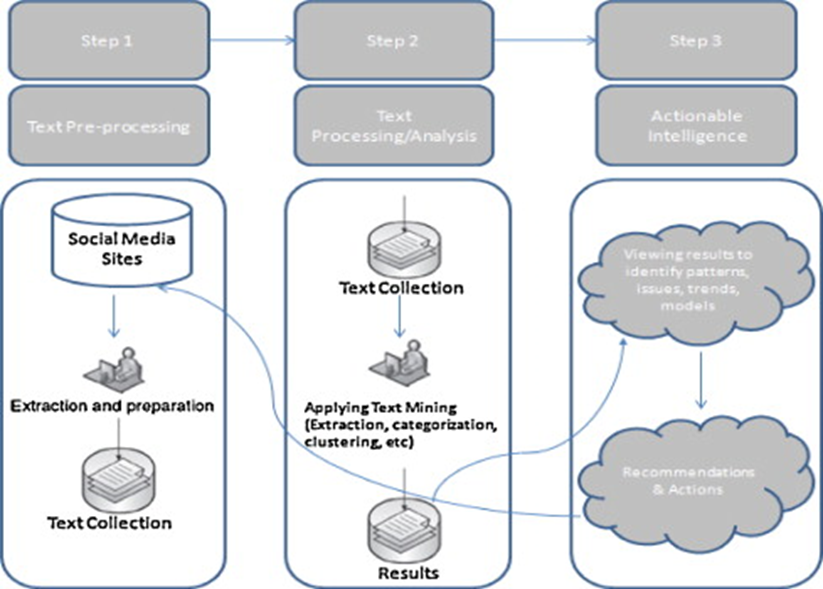
Data analysis
The data analysis method was chosen based on the data collection tools and methods through the software by www.app.quintly.com. This study utilized the exploratory quantitative approach to determine and characterize the creative strategies used by Mac Cosmetics. In particular, likes, shares and comments were analyzed as well as the total number of subscribers. The collected data was presented in the form of tables and figures to visualize findings. Statistical formulas were utilized to analyze the change in the number of fans and other related data.
Data Findings
In the period between January 2017 and December 2017, the total number of fans changed from 391,740 to 468,066 followers, while the most significant positive change in approximately four per cent was noted in November (See Figure 2). Summertime was characterized by a gradual reduction in the number of fans that, probably, is associated with the overall decrease in the use of social networks at this time (See Figure 3). Along with this, social interaction is the major gratification received by social media users, and, therefore, the degree of customers’ involvement in communication on MAC’s social media pages can be regarded as a sign of the company’s marketing strategy success.
The interaction rates show that the most active interaction of users was noted on June 0.9107 compared to 0 in December and might be due to the holidays season (See Figure 4). More to the point, one should stress that shorter posts with image appeal acquired more likes and shared in comparison to long ones. The total interaction rates ranged between 12.806 and 0. Accordingly, the posts that attracted more customer engagement may be marked with a high I-rate and a maximum of comments and shares (See Figure 5).
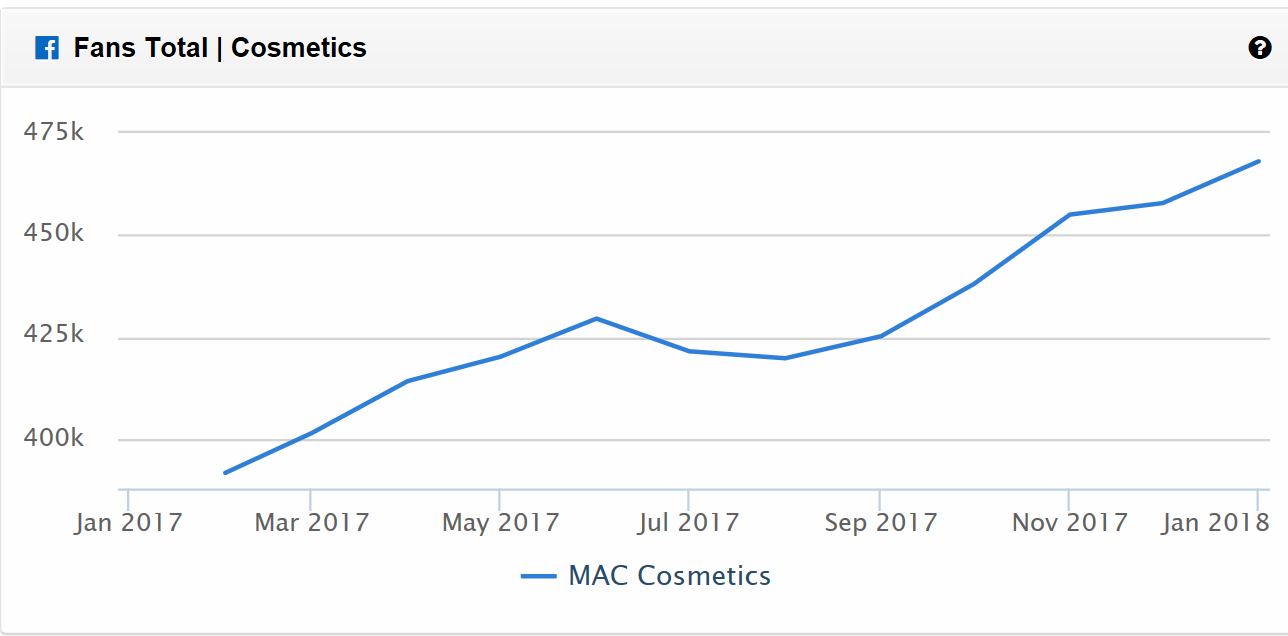
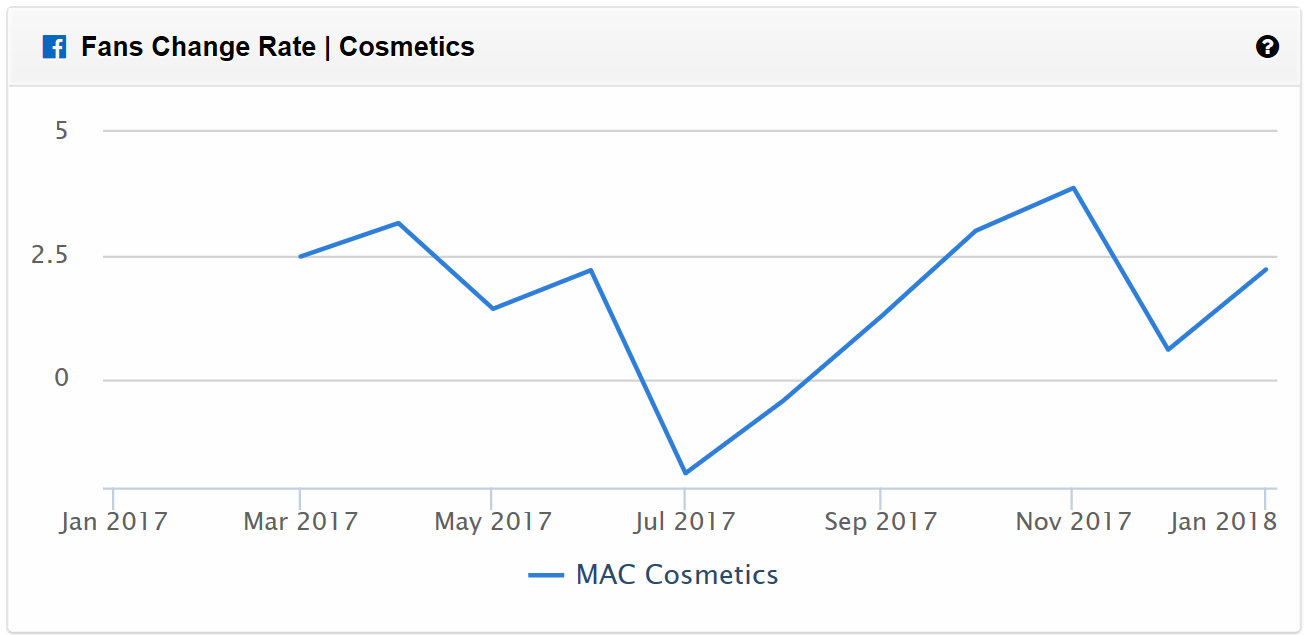
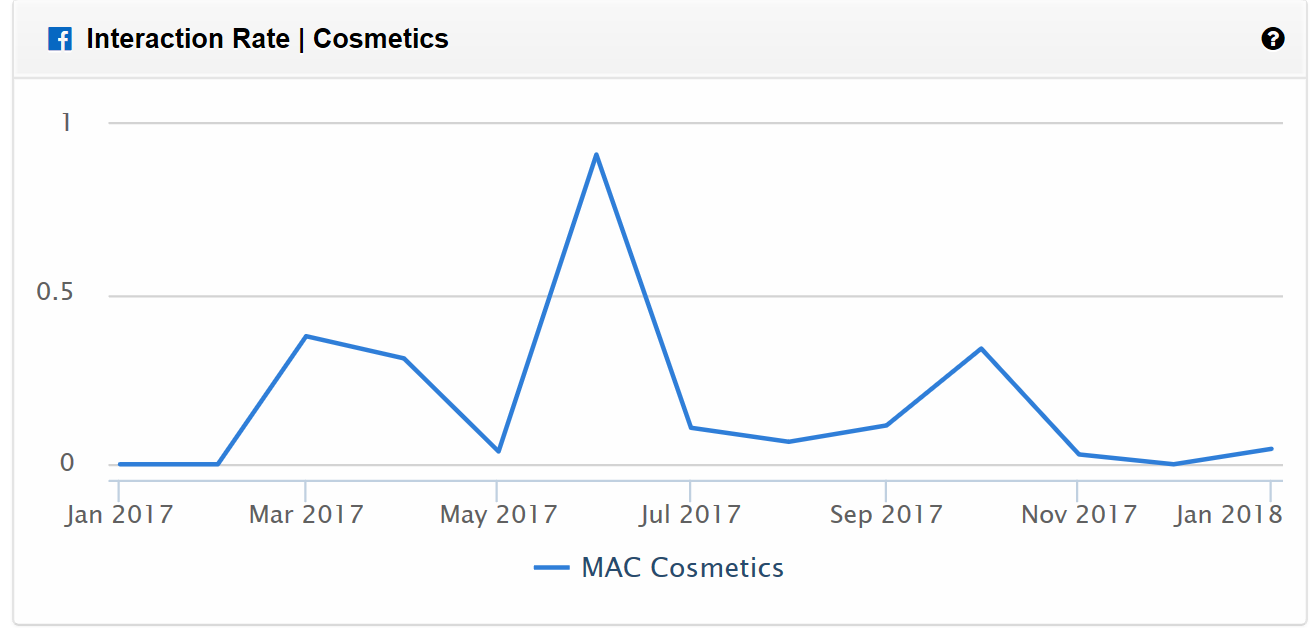
Figure 5.
Figure 5: Column descriptions:
- Reactions: Likes + Love + Wow + Haha + Sad + Angry
- Negative Reactions: Angry
- Interactions: Reactions + Comments + Shares
- Type: Showing the type of the post (e.g. video).
- Shared Post: Whether or not the post is a shared post.
- Spherical Content: Whether or not the post contains a 360° video or photo.
- Sponsored: ‘Highly Likely’, ‘Highly Unlikely’, ‘Not yet classified’. ‘Not yet classified’ means it has not yet been determined whether the post may be sponsored or not. This can sometimes take a few days after the post has been added.
- Interaction Rate: The sum of Reactions, Comments and Shares per post, standardized by the total amount of Fans.
It was important to analyse data with regard to time of publications. The results show that most of posts are published between 5 and 13. As for days of the week, one may detect such tendency as the publications on Monday, Tuesday, Wednesday, Thursday, and Sunday. The comparison of matches between the posts and interaction was also analysed. It was revealed that Tuesday from 12 to 13 is the time when three percent of customer reacted. Wednesday from 14 to 15, Thursday from 7 to 8, and Sunday from 8 to 9 and from 12 to 14 can be noted as vivid conformity between interaction rates and MAC Cosmetics’ posts.
In conclusion, the highest interactions were on Thursday followed by Monday and Tuesday between 1 to 3 and 11 to 13. (See Figures 6,7).
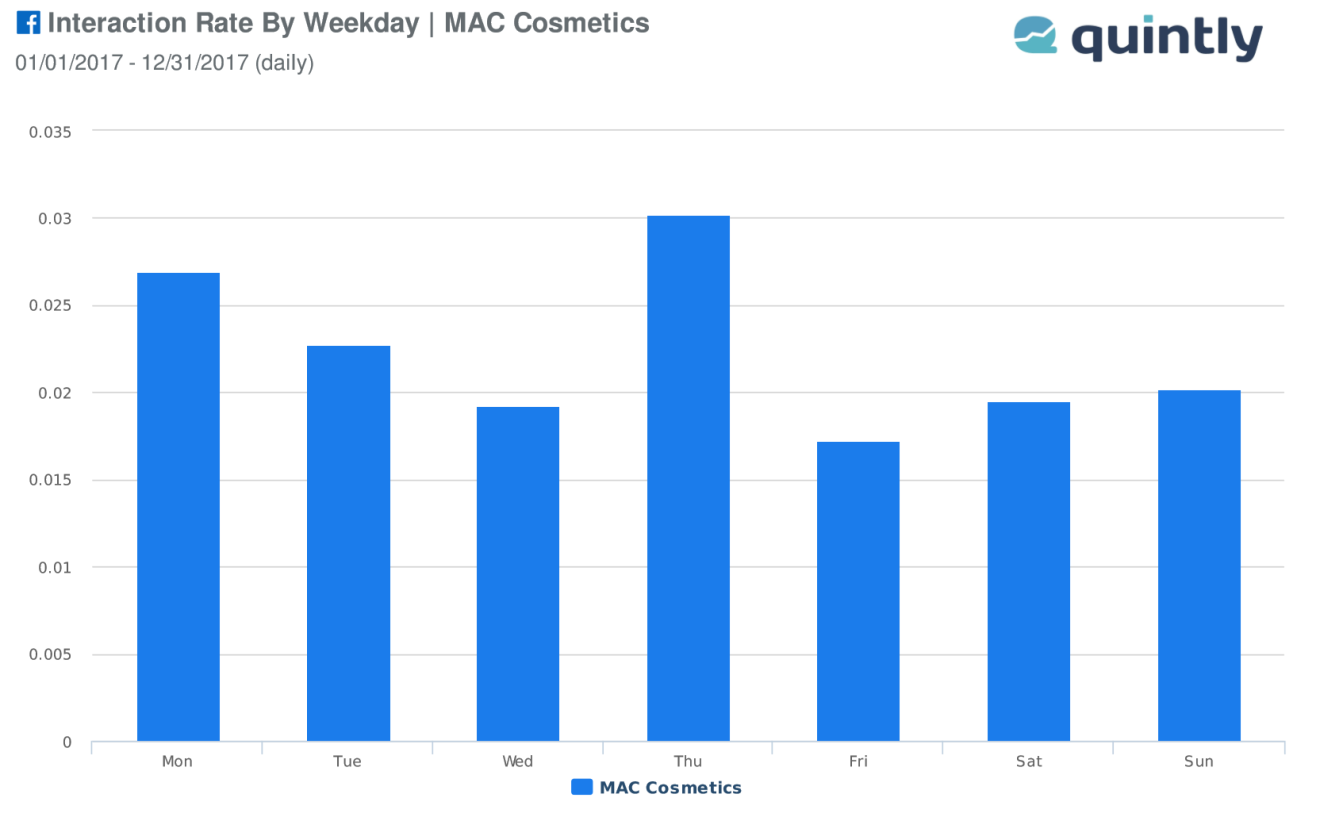
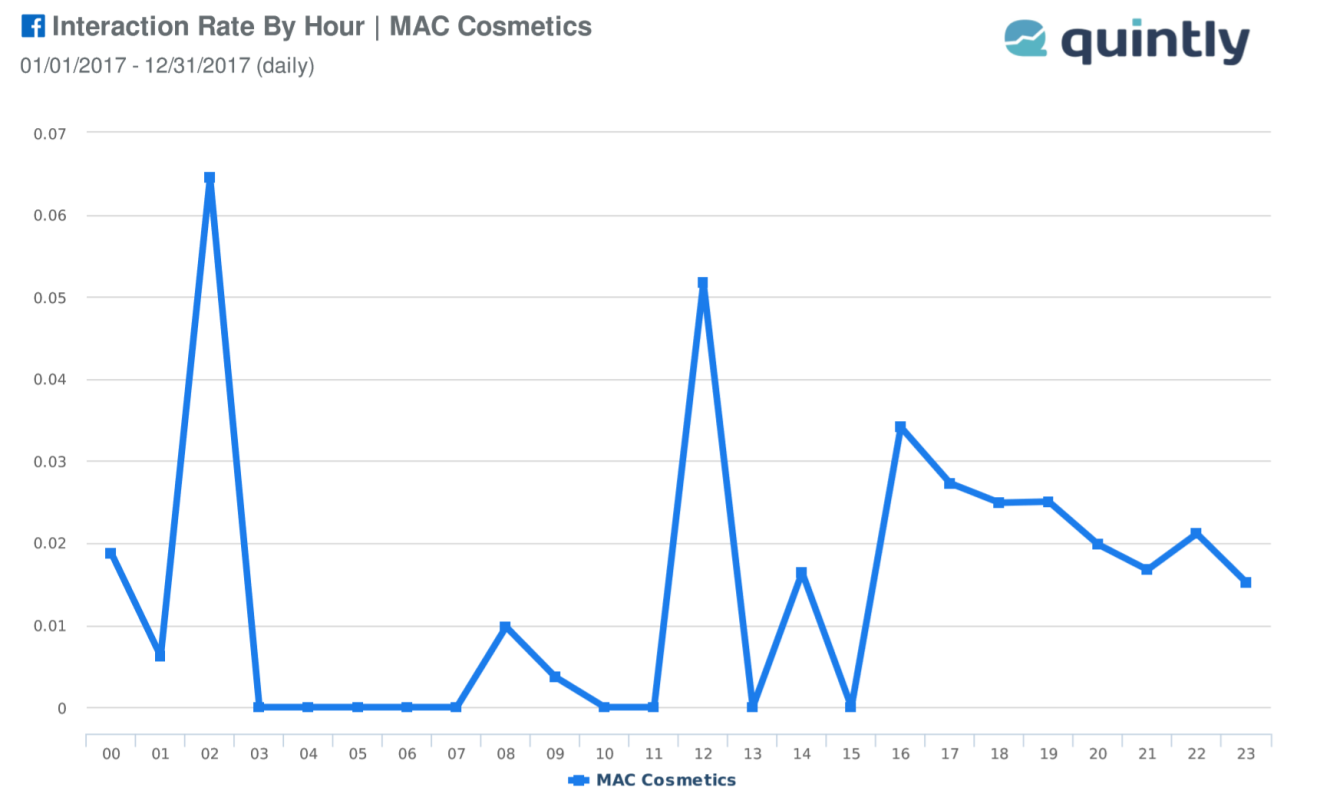
The type of posts such as; Links, Live videos, Photos, Videos and YouTube videos shared were analysed in terms of customers interactions were also analysed to determine what type created the highest interactions that would help MAC cosmetic to determine what type should be considered in future communications. It was detected that YouTube videos had the highest interaction rates followed by videos and photos. (See Figure 8)
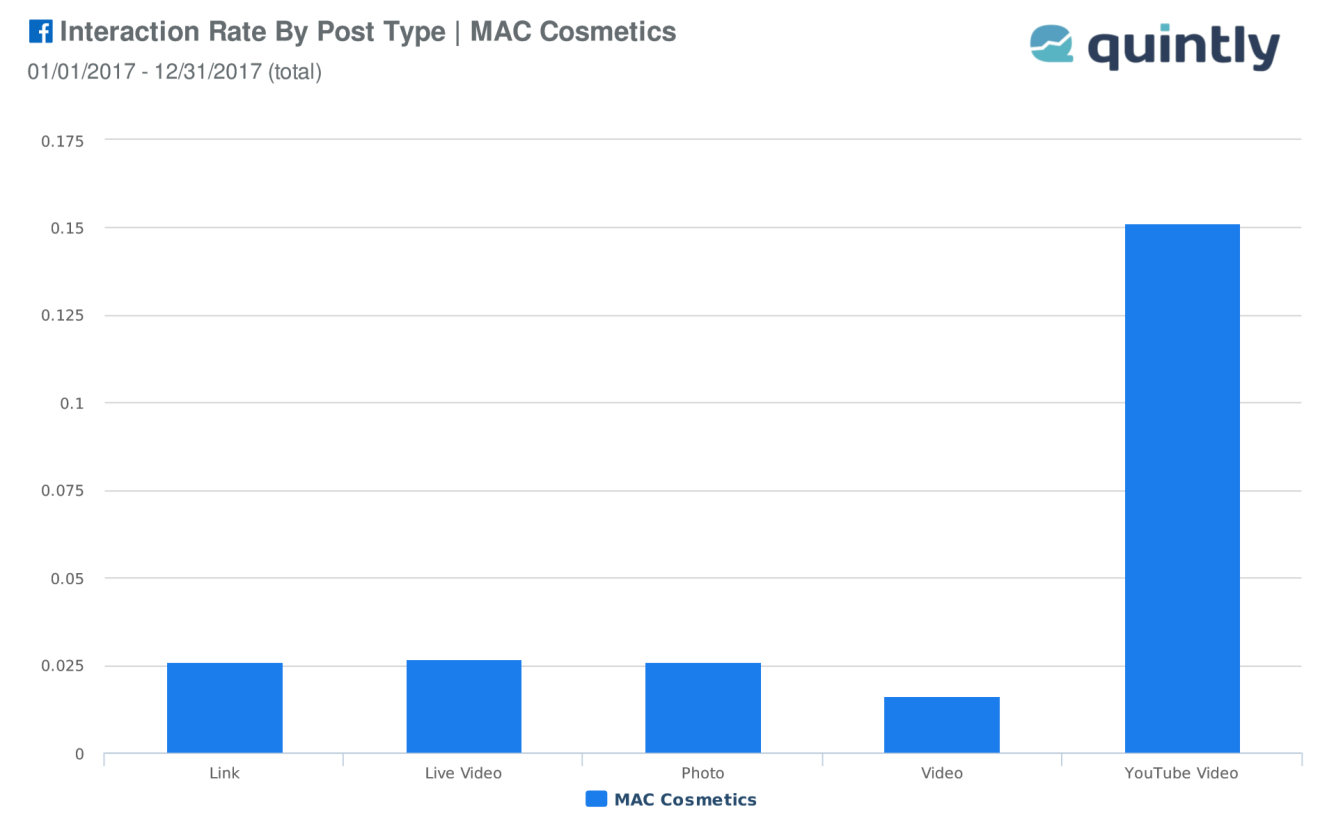
Discussion and Conclusions
The research study results indicate that the strategies of social media affect customer engagement positively by increasing their loyalty and motivation to cooperate with companies in a long-term perspective. Most importantly, the theory of the Uses and Gratifications considered as the conceptual framework for this research. Based on the results obtained, several assumptions may be provided.
First, one should note that Facebook as a social media plays an important role in creating customer engagement, and the raise in the number of customers and their reactions prove it. The most significant function of this social network in terms of MAC Cosmetics page is deeper involvement of users to increase the probability of selling them something after the company has built a trusting relationship. For example, the company’s representatives can post a free information report on the fan page on Facebook and promote this content or organise a free event, for example, a webinar or a beauty related event. In response, it is possible to expect that many customers would like or share it, thus increasing the overall profitability.
In this case, MAC Cosmetics acquires the opportunity to sell its products to customers when it confirms the status of an expert in this area. The review of the results shows that when promoting an event created with Facebook, the name of the ad should be the name of the event by default. The title of the most eye-catching posts immediately attracts the attention of readers, while there are about multiple characters of the message text to interest and captivate them. Such posts, as a rule, have an image that is related to the topic of the post. This picture or short video can be the most important element of the advertising.
Facebook users are focused on images as it is the largest resource in the world for placing photographs, and they from the visual presentation of the posts, thus largely defining its success (Ashley and Tuten) 2014. In addition, MAC cosmetics replies to customers comments come in Arabic or English according to the customer language to be more convenient and feel closer to the brand. (See Figure 9, 10).
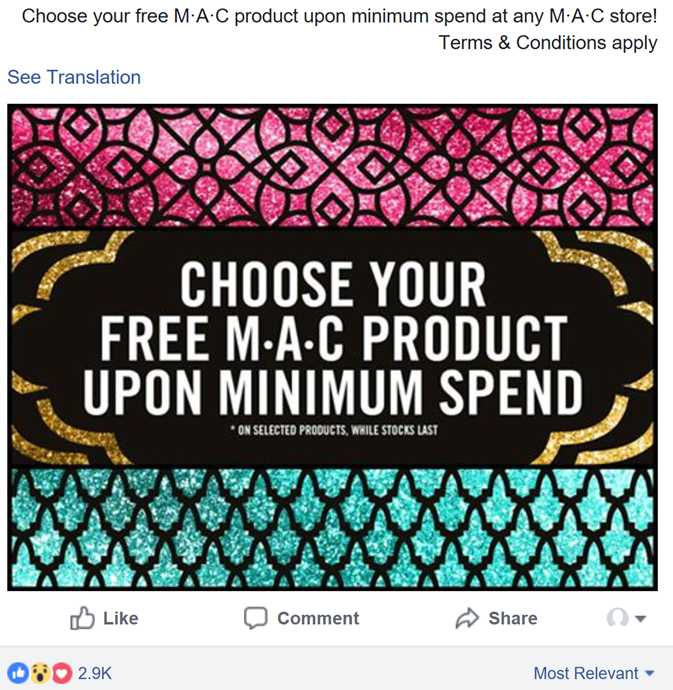
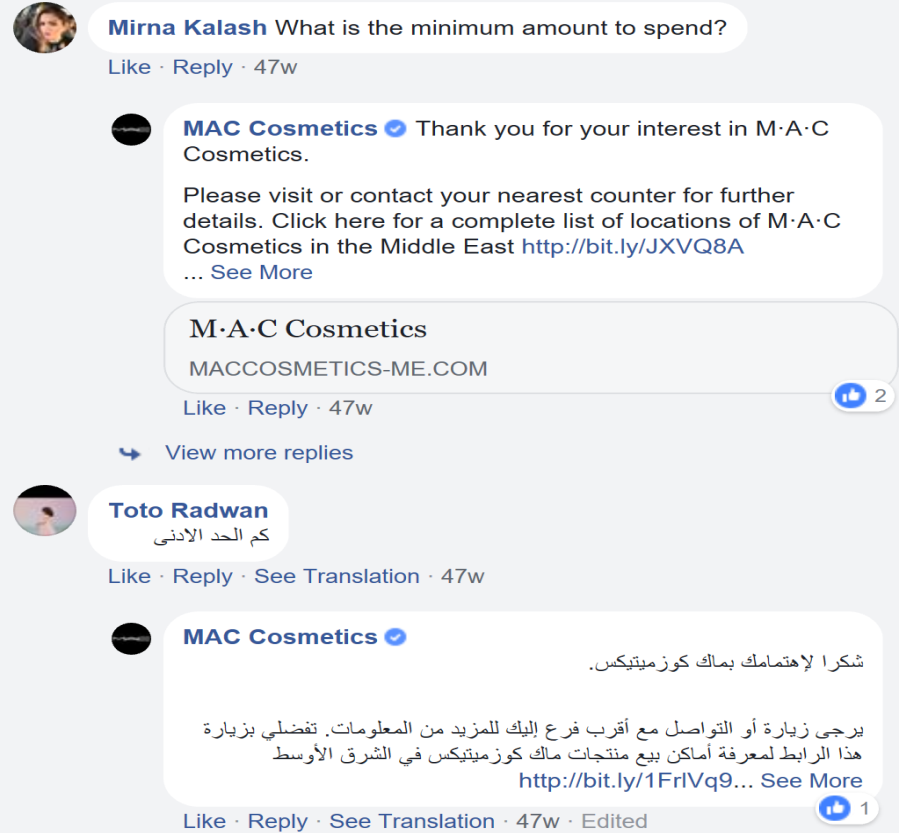
Second, the main creative strategies utilised by MAC Cosmetics on its Facebook page are as follows: psychological engagement through creative messages and branded social content, elaborate time of posts, targeting, and providing valuable recommendations. It is possible to suggest that MAC Cosmetics is aware of those time periods that are most preferred by their customers to reviews Facebook posts. Considering that the brand provides resourceful and helpful information to its social media followers, it is valid to say that its strategy integrates the informational UGT construct well. The company tries to publish when its subscribers are online to boost interaction. One may notice that the time and days for perfect posting differ in different studies, and these results are correct.
Specifically to this research, Cosmetics is used primarily by women who tend to get up early in the morning and look at Facebook at breakfast. Others are undermined, going for half an hour and running out of the house to a workplace. Some people come and study the news before the arrival of a boss, and others devote the first hours of active work and then relax and enter the social network. Friday evening as a holiday is characterised by family evenings and hours spent at home, looking through the news in the social media. Understanding the mentioned issues, MAC Cosmetics publishes posts when its fans are online. The company studies the statistics and adjusts to the audience accordingly.
In terms of its creative strategies, the company also adds photos, videos, or infographics to its posts to make them more catching and informative for customers to drive their reactions.
Nowadays, photo content does not lose its positions as it is still popular on Facebook. MAC Cosmetics publishes photos and videos of real people: their associated stars, actors, or partners. There may be noted the series of posts with examples of using the products. This creative strategy is effective since catchy photos that are difficult to miss in the news feed. As for infographics, it is the easiest way to show the customers some important information that is easily remembered and shared with friends most often compared to usual posts.
The publication of videos seems to facilitate a higher coverage of fans and a greater interaction. The discussed type of content may be regarded as entertaining (consistently with the definition of the entertainment construct of the UGT provided above in the paper). By integrating it in promoting campaigns, not only does MAC capture users’ attention better but also promotes their positive attitudes to posted advertisements as such. Consequently, the use of entertaining content allows increasing consumers’ return to websites/social media pages, and contribution to brand-associated online content.
Being useful, MAC Cosmetics strives to provide valuable information. Since it is free and, at the same time important there is greater probability that this type of posts will be shared. The above strategy may be classified as psychological engagement though social content. As far as the publication of useful information on Facebook page automatically increases its weight in the eyes of friends, customers tend to share it as this type of content contributes to the formation of a positive self-status and preservation of contacts with peers and community members.
Since the sharing of valuable brand-related information helps fulfil one’s need and motivation to socialise, the posting of valuable information by MAC is consistent with relational UGT construct. However, the results show that such posts are frequent, yet saturated with useful content to a maximum. Targeting was used to attract and retain female customers. Creative messages used by the analysed Facebook page were short yet informative (See Figure 11).
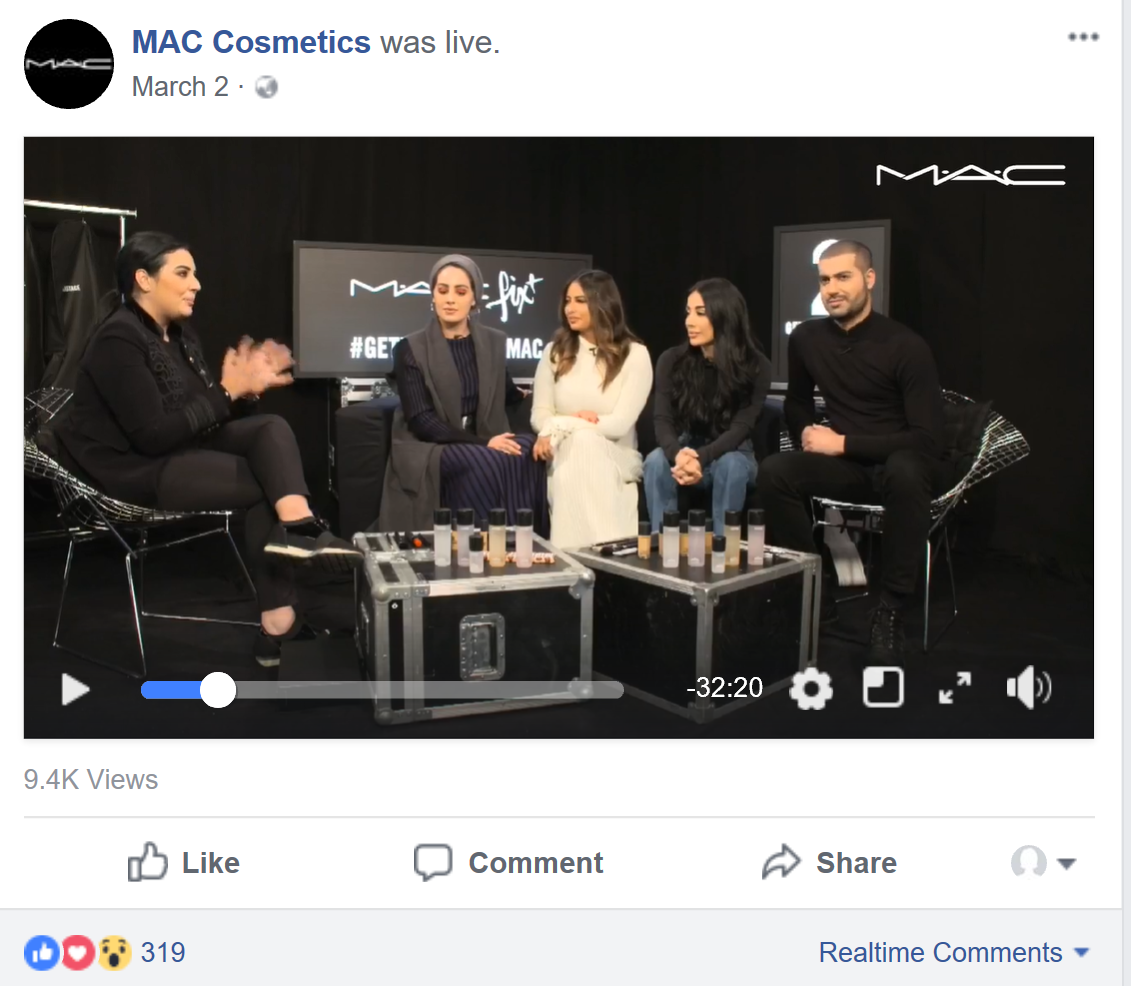
Third, the study results revealed that there is a direct correlation between customer engagement and customer experience, namely, previous studies may be used to shape the future strategies. A customer’s trust in the company, loyalty, and readiness to continue to act and increase the volume of activity as well as use new products and services directly depend on the level of service and customer experience gained. Currently, in order to increase the company’s focus on customers, MAC Cosmetics comes to the conclusion that it is necessary to manage not only customer relationships but also their experiences.
A client experience includes the totality of all the emotions and perceptions received by him or her when buying products during the entire time of interaction with the supplier: from information retrieval and evaluation to the direct contact, purchase, use, and even participation in disseminating positive information among other people. To assess such emotional impressions, it is critical to establish feedback with fans, and in order to manage them, one should have an idea of their preferences, behaviour patterns, and hierarchy of values of certain customer groups. When brands have similar values to their customers they can transmit communications leading to achieve stronger relationship with the brand leading greater customer engagement and loyalty (De Vries and Carlson) 2014.
Customer engagement and integration of UGT construct in social media marketing strategies and activities allows managing customer relationships and creating customer experiences. The analysis of customer data, their behaviours, and subsequent segmentation makes it possible, for example, to identify offers that are unique to target groups and develop interaction scenarios. Nevertheless, it is important not to overestimate the role of customer engagement in the formation of expectations and behaviours of the customers.
The key influence on customer experience is the actual quality of products along with the level of service (Ashley and Tuten) 2014. Preferably, customer engagement system should not only store and take into account all information about the clients but also analyse the behavioural patterns, which form the models of consumer experience. With the help of such initiatives and the personified interaction with a client, it is quite possible to change his or her behaviour, thus forming consumer experience.
Theoretical/Academic contributions
Discussing the given study in terms of theoretical contributions, one should stress the fact that little is known about the creative strategies that may be used to engage customers through social networks. Even though some theoretical information exists, the practical studies are limited. In this regards, the exploratory research on how Facebook page may be used to involve customers cannot be overestimated. The implications of the given study may be used by theorists in their future studies to either verify or reject them as well as to enrich the statements provided in this paper.
More to the point, this study seems to be of great importance to specialists working in the field of customer experience. In particular, they may improve their knowledge of its role in social media strategies. In terms of the Uses and Gratifications theory, this research contributes to what is already known about it by presenting new opportunities on its use and providing the opportunity to create new strategies that are to be then used in practice.
Managerial/Practical/Policy contributions
At the same time, practical implications should be identified as they matter for experts in social media marketing, management, and user experience. People working directly in the mentioned field may use the findings of this paper in their workplaces. Since the creative strategies utilised by MAC Cosmetics proved to be effective, it is possible to expect that would be beneficial for other companies as well.
In addition, the research findings may be interesting to average readers, who use MAC Cosmetics and are engaged in its social media pages. Such readers may be willing to positively affect the social media presence of this company by enhancing its interaction with customers. The mutually-advantageous nature of such interaction shows that both sides are active participants of communication and both of them may impact each other.
Research limitations & Areas for future research
The research limitations refer to the target population and timeframe of the research. Since the study was conducted with a focus on the United Arab Emirates, it cannot be generalised to other countries. Nevertheless, the results received are valid and reliable for the mentioned country. The second limitation is associated with timeframe selected by a researcher, namely one year. Perhaps, it would be better if the study took into account a wider period of time to make the findings more representative.
The above limitations provide the perceptive for further research. In other words, it is possible to suggest that there is a need to compare the mentioned findings with the strategies used in the US, the UK, and other large countries with a focus on cultural specifics. Another potential area for the future research is two and more year studies that would allow receiving long-term period results and making more relevantconclusions.
Conclusion
In conclusion, it is important to emphasize that this exploratory research targeted the study of the role of MAC Cosmetics’ Facebook page in customer engagement creation. It was revealed that the mentioned company is quite effective in its communication through this social media as the number of fans, likes, and shares increased significantly within one year. The psychological engagement based on social content as well as proper format of posts was recognized as the most successful creative strategies.
The results obtained demonstrate the direct correlation between customer engagement and customer experience since social media is a useful tool as what have been captured from the literature review and findings. In their turn, customers proved to be active participants of the interaction with MAC Cosmetics in the context of the Uses and Gratifications theory that was applied as the conceptual framework. The study findings show that Facebook is an important tool to communicate with customers based on paying attention to their preferences, expectations, and needs.
References List
Ashley, C & Tuten, T 2014, ‘Creative strategies in social media marketing: an exploratory study of branded social content and consumer engagement’, Psychology & Marketing, vol. 32, no.1, pp.15-27.
Chua, AY & Banerjee, S 2013, ‘Customer knowledge management via social media: the case of Starbucks’, Journal of Knowledge Management, vol. 17, no. 2, pp. 237-249.
De Vries, N & Carlson, J 2014, ‘Examining the drivers and brand performance implications of customer engagement with brands in the social media environment’, Journal of Brand Management, vol. 21, no. 6, pp.495-515.
Dolan, R, Conduit, J, Fahy J & Goodman S 2015, ‘Social media engagement behaviour: a uses and gratifications perspective’, Journal of Strategic Marketing, pp. 1-17.
He, W, Zha, S & Li, L 2013, ‘Social media competitive analysis and text mining: a case study in the pizza industry’, International Journal of Information Management, vol. 33, no. 3, pp.464-472.
Heather, H 2014, MAC Cosmetics’ social media strategy triumphs over L’Oreal, Benefit and Chanel. Web.
Hoffman, D & Fodor, M 2010, Can you measure the ROI of your social media marketing?. Web.
Jansen, BJ, Zhang, M, Sobel, K & Chowdury, A 2009, ‘Twitter power: tweets as electronic word of mouth’, Journal of the American Society for Information Science and Technology, vol. 60, no. 11, pp. 2169-2188.
John, L, Emrich, O, Gupta, S & Norton, M2017, ‘Does “liking” lead to loving? The impact of joining a brand’s social network on marketing outcomes’, Journal of Marketing Research, vol. 54, no. 1, pp.144-155.
Jowett, V 2016, MAC’s unisex makeup collection with the Brant brothers is all kinds of amazing. Web.
Keller, K 2009, ‘Building strong brands in a modern marketing communications environment’, Journal of Marketing Communications, vol. 15, no. 2, pp.139-155.
Kumar, A, Bezawada, R, Rishika, R, Janakiraman, R & Kannan, A 2016, ‘From social to sale: the effects of firm-generated content in social media on customer behavior’, Journal of Marketing, vol. 80, no. 1, pp.7-25.
Lovejoy, K, Waters, RD & Saxton, GD 2012, ‘Engaging stakeholders through Twitter: how nonprofit organizations are getting more out of 140 characters or less’, Public Relations Review, vol. 38, no. 2, pp. 313-318.
Luo, X 2002, ‘Uses and gratifications theory and e-consumer behaviors: a structural equation modeling study’, Journal of Interactive Advertising, vol 20, no.2, pp. 34–41.
MAC 2018, MAC, New York, NY, Web.
Mangold, W & Faulds, D 2009, ‘Social media: the new hybrid element of the promotion mix’, Business Horizons, vol. 52, no. 4, pp.357-365.
Martin, K & Todorov, I 2010, ‘How will digital platforms be harnessed in 2010, and how will they change the way people interact with brands?’, Journal of Interactive Advertising, vol. 10, no. 2, pp. 61–66.
Musa, AS, Azmi, MNL & Ismail NS 2015, ‘Exploring the uses and gratifications theory in the use of social media among the students of mass communication in Nigeria’, Malaysian Journal of Distance Education, vol. 17, no. 2, pp. 83-95.
Park, H & Kim, Y 2014, ‘The role of social network websites in the consumer–brand relationship’, Journal of Retailing and Consumer Services, vol. 21, no. 4, pp.460-467.
Pereira, H, de Fátima Salgueiro, M & Mateus 2014, ‘Say yes to Facebook and get your customers involved! Relationships in a world of social network’, Business Horizons, vol. 57, no. 6, pp.695-702.
Peters, K, Chen, Y, Kaplan, A, Ognibeni, B & Pauwels, K 2013, ‘Social media metrics: a framework and guidelines for managing social media’, Journal of Interactive Marketing, vol. 27, no. 4, pp. 281-298.
Phua, J, Jin, S & Kim 2017, ‘Gratifications of using Facebook, Twitter, Instagram, or Snapchat to follow brands: the moderating effect of social comparison, trust, tie strength, and network homophily on brand identification, brand engagement, brand commitment, and membership intention’, Telematics and Informatics, vol. 34, no. 1, pp. 412-424.
Prance, L 2007, MAC announces Barbie Cosmetics range for adults. Web.
Quan-Haase, A & Young, AL 2010, ‘Uses and gratifications of social media: a comparison of Facebook and instant messaging’, Bulletin of Science, Technology & Society, vol. 30, no. 5, pp.350-361.
Rao, S 2012, ‘Facebook for businesses’, Vikalpa: the Journal for Decision Makers, vol. 37, no. 4, pp. 90-92.
Reportlinker 2017, UAE cosmetic products market. Web.
Rishika, R, Kumar, A, Janakiraman, R & Bezawada, R 2013, ‘The effect of customers’ social media participation on customer visit frequency and profitability: an empirical investigation’, Information Systems Research, vol. 24, no. 1, pp. 108-127.
Romero, C & Ventura, S 2010, ‘Educational data mining: a review of the state of the art’, IEEE Transactions on Systems, Man, and Cybernetics, Part C (Applications and Reviews), vol. 6, no. 2, pp.601-618.
Schiffer, J 2018, Instagram appeal: how social media is changing product development in beauty. Web.
Schmitt, B 2012, ‘The consumer psychology of brands’, Journal of Consumer Psychology, vol. 22, no. 1, pp.7-17.
Sheehan, K & Morrison, N 2009, ‘The creativity challenge: media confluence and its effects on the evolving advertising industry’, Journal of Interactive Advertising, vol. 9, no. 1, pp. 40-43.
Sheldon, P & Bryant, K 2016, ‘Instagram: motives for its use and relationship to narcissism and contextual age’, Computers in Human Behavior, vol. 58, no. 1, pp. 89-97.
Shen, B & Bissell, K 2013, ‘Social media, social me: a content analysis of beauty companies’ use of Facebook in marketing and branding’, Journal of Promotion Management, vol. 19, no. 5, pp. 629-651.
Socialbakers 2018, Which beauty Facebook pages like fans in United Arab Emirates. Web.
Spasic, I, Ananiadou, S, McNaught, J & Kumar, A 2005, ‘Text mining and ontologies in biomedicine: making sense of raw text’, Briefings in Bioinformatics, vol. 6, no. 3 , pp.239-251.
StatCounter Global Stats 2018, Social media stats United Arab Emirates. Web.
Statista 2018, Facebook: leading beauty brand followers 2017. Web.
Stelzner, M 2018, 2015 social media marketing industry report. Web.
Stewart, D & Koslow, S 1989, ‘Executional factors and advertising effectiveness: a replication’, Journal of Advertising, vol.18, no. 2, pp. 21-32.
Sundar, SS & Limperos, AM 2013, ‘Uses and grats 2.0: new gratifications for new media’, Journal of Broadcasting & Electronic Media, vol. 57, no. 4, pp. 504-525.
Vaiciukynaite, E, Massara, F & Gatautis, R 2017, ‘An investigation on consumer sociability behaviour on Facebook’, Engineering Economics, vol. 28, no. 4, pp.467-474.
Viveiros, BN 2013, Mattel becomes relevant again by reinventing Barbie. Web.
Whiting, A & Williams, D 2013, ‘Why people use social media: a uses and gratifications approach’, Qualitative Market Research: An International Journal, vol. 16, no. 4, pp. 362-369.
Wirtz, J, den Ambtman, A, Bloemer, J, Horváth, C, Ramaseshan, B, van de Klundert, J, Zeynep Gurhan, C & Kandampully, A 2013, ‘Managing brands and customer engagement in online brand communities’, Journal of Service Management, vol. 24, no. 3, pp. 223-244.